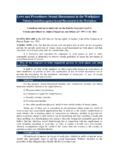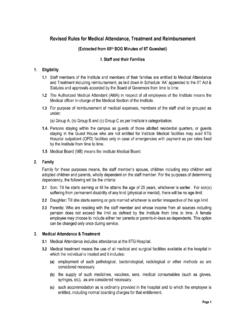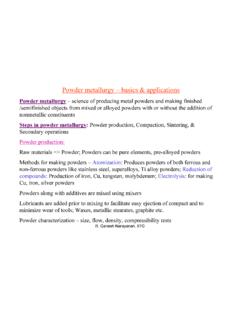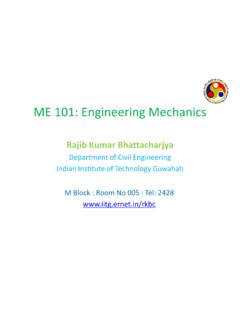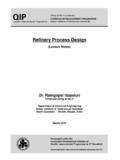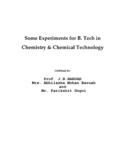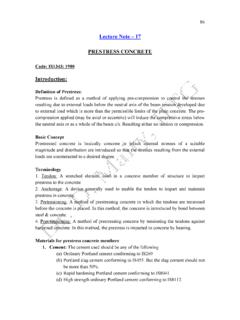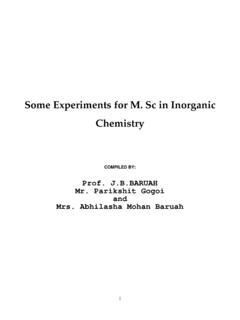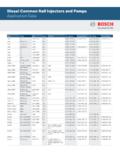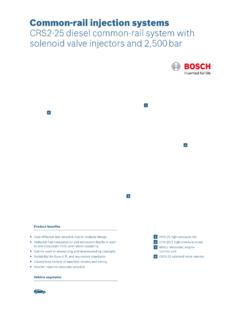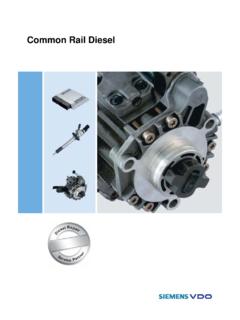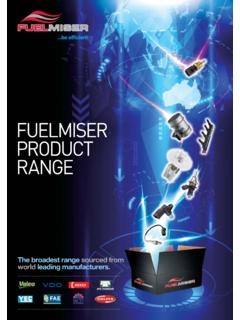Transcription of Internal Combustion Engines - iitg.ac.in
1 1 Internal Combustion EnginesLecture-12 UjjwalKSaha, of Mechanical EngineeringIndian Institute of Technology GuwahatiPrepared underQIP-CD Cell Project2 diesel Engines -Facts The diesel engine is a type of Internal Combustion engine (more specifically, a compression ignition engine) in which the fuel is ignited by being suddenly exposed to the high temperature and pressure of a compressed gas containing oxygen (usually atmospheric air), rather than a separate source of ignition energy (such as a spark plug), as is the case in the petrol engine.
2 This is known as the diesel cycle, after German engineer Rudolf diesel ,who invented it in 1892and received the patenton February 23, Initial CI Engines were large and slow. Heavy distillate petroleum was forced into the cylinder using compressed air. Robert Bosch began producing injection systems in 1927. diesel Engines -Facts4CI vs. SI EnginesCI vs. SI Engines SI Engines draw fuel and air into the cylinder. Fuel must be injected into the cylinder at the desired time of Combustion in CI Engines .
3 Air intake is throttled to the SI engine --no throttling in CI Engines . Compression ratios must be high enough to cause auto-ignition in CI Engines . Upper compression ratio in SI Engines is limited by the auto-ignition temperature. Flame front in SI Engines smooth and controlled. CI Combustion is rapid and uncontrolled at the Engines -Facts In very cold weather, diesel fuel thickens and increases in viscosity and forms wax crystals or a gel. This can make it difficult for the fuel injector to get fuel into the cylinder in an effective manner, making cold weather starts difficult at times, though recent advances in diesel fuel technology have made these difficulties rare.
4 6 diesel Engines -Facts A common method to electrically heat the fuel filter and fuel lines. Other Engines utilize small electric heaters called glow plugs inside the cylinder to warm the cylinders prior to starting. A small number use resistive grid heaters in the intake manifold to warm the inlet air until the engine reaches operating temperature. 7 diesel Engines -Facts A vital component of any diesel engine system is the governor,which limits the speed of the engine by controlling the rate of fuel delivery.
5 Older governors were driven by a gear system from the engine (and thus supplied fuel only linearly with engine speed.) Modern electronically-controlled Engines achieve this through the electronic control module (ECM) or electronic control unit (ECU).8 diesel Engines -Facts The addition of a turbocharger or supercharger(boost pressures can be higher on diesels) to the engine greatly assists in increasing fuel economyand power output. The higher compression ratioallows a diesel engine to be more efficient than a comparable spark ignition engine, although the calorific valueof the fuel is slightly lower at MJ/kg to gasoline at MJ/kg.
6 9 diesel Engines -Applications High-Speed (approximately 1200 rpm and greater) Engines are used to power lorries (trucks), buses, tractors, cars, yachts, compressors, pumps and small generators. Large electrical generators are driven by medium speed Engines , (approx. 300 to 1200 rpm) optimized to run at a set speed and provide a rapid response to load changes. The largest diesel Engines are used to power ships. These Engines have power outputs over 80,000 kW, turn at about 60 to 100 rpm, and are up to 15 m tall.
7 They often run on cheap low-grade fuel, which require extra heat treatment in the ship for tanking and before injection due to their low Injection System -Requirements The injected fuel must be broken into very fine droplets The fuel injection should occur at the correct moment It should supply the fuel in correct quantity as required by the varying engine loads The spray pattern should ensure rapid mixing of fuel and air It should supply equal quantities of metered fuel to all the cylinders in a multi cylinder Engines The beginning and the
8 End of injection should be sharp 11 Elements of Fuel Injection System Distribution elements: to divide the metered fuel equally among the cylinders Pumping elements: to supply fuel from fuel tank to cylinder Metering elements: to meter fuel supply as per load and speed Timing controls: to adjust the start and the stop of injection Mixing elements: to atomize and distribute the fuel within the Combustion chamber12 Types of Injection Systems Air (Blast) Injection System: In air blast injection system, fuel is forced into the cylinder by means of compressed air.
9 This method is capable of producing better atomization and penetration of fuel resulting in higher brake mean effective pressure. This system is little used universally at present, because it requires a multistage air compressor, which increases engine weight and reduces brake power. 13 Types of Injection Systems Contd. Solid Injection System:In solid injection, the liquid fuel is injected directly into the Combustion chamber without the aid of compressed air.
10 Hence, it is termed as airless mechanical injection or solid injection. Every solid injection system must have a pressuring unit (the pump)and an atomizing unit (the injector).14 Solid Injection -Classification Depending upon the location of the pumps and injectors, and the manner of their operations, solid injection systems may be further classified as follows: Common Rail System Unit Injection System Individual Pump and Nozzle System Distributor System15 In this system, a high-pressure pump supplies fuel to a fuel header as shown.
